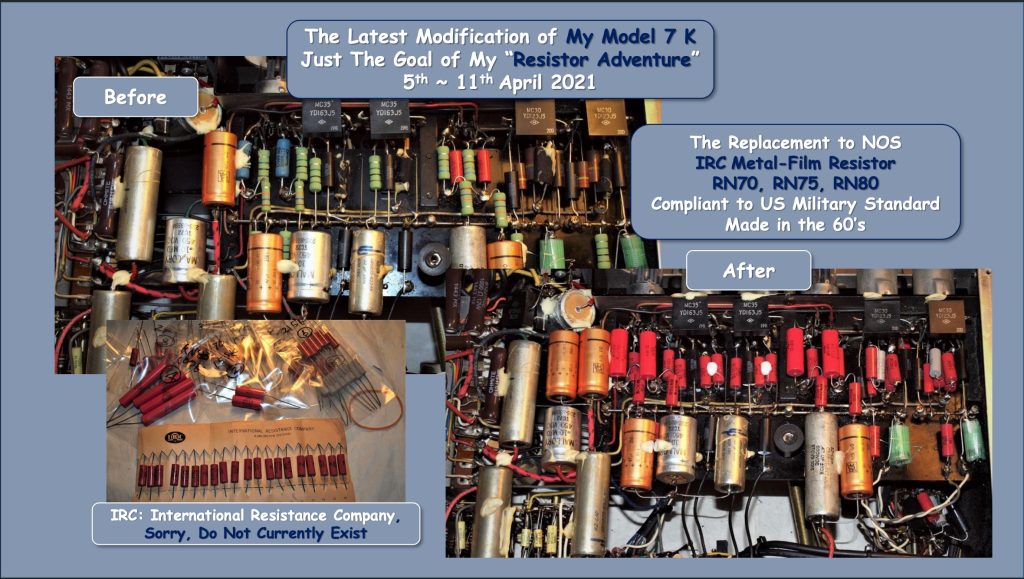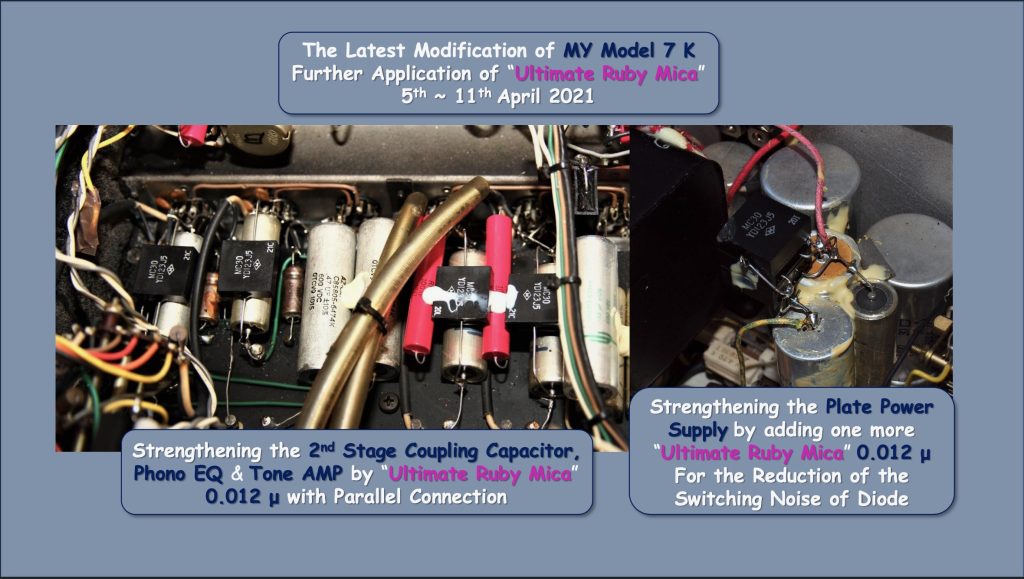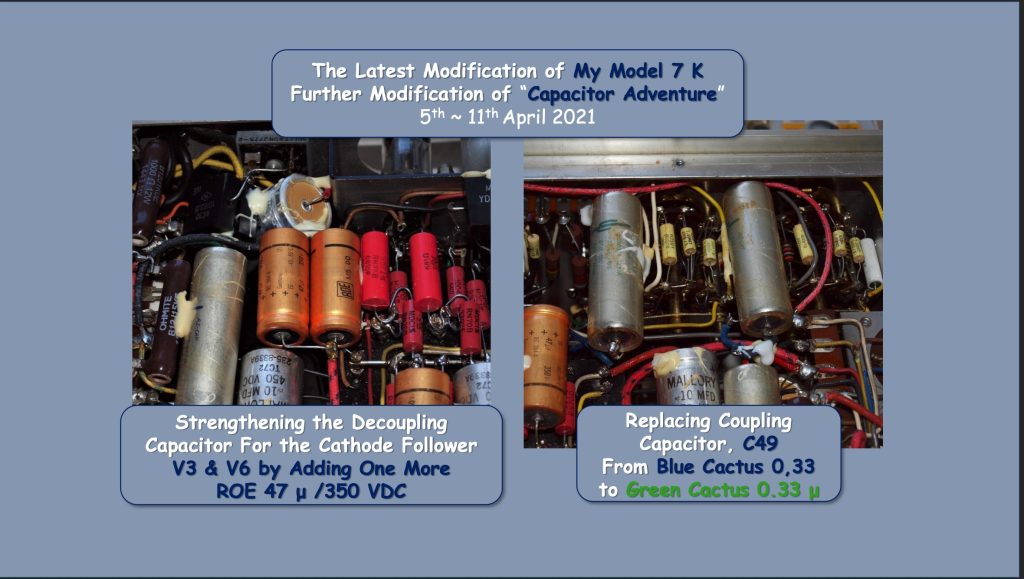Tube Selection for Model 7
As the final chapter of this Part 10, I would like to clarify my view on the active elements, that is, 12AX7 or ECC83.
I have already discussed the famous tube, Telefunken ECC83, originally inserted into the Model 7 Original:
“The genuine Telefunken ECC83’s sound image is so precise and fine, but a little bit slim and tight, and so it could compensate for the retro but atmospheric sound of original Model 7, mainly due to the use of Allen-Bradley carbon composition resistors, Sprague Bumble Bee's for coupling capacitors, or Selenium diodes.”
This consideration has not changed. In a state where the sound quality is dramatically improved by much higher quality passive elements, there should be another tube selection, I think, and so, I’d like to introduce you the tube layout of Alan-san’s and Ryszard-san’s Model 7 for your reference.

V1: Ch. B (Right) the first stage and the second stage of Phono EQ,
V2: Ch. A (Left) the first stage and the second stage of Phono EQ,
- Alan-san’s Model 7: SIEMENS ECC83
- Ryszard-san’s Model 7: RCA 12AX7A
V3: Ch. A and Ch. B (Left and Right) the output stage or the cathode follower of the Phono EQ,
- Alan-san’s Model 7: RCA 12AX7 (Grey Long Plate)
- Ryszard-san’s Model 7: RCA 12AX7 (Grey Long Plate)
V4: Ch. B (Right) the first stage and the second stage of Tone AMP,
V5: Ch. A (Left) the first stage and the second stage of Tone AMP,
- Alan-san’s Model 7: PHILIPS ECC83 /12AX7 (Long Plate)
- Ryszard-san’s Model 7: RCA12AX7 (Grey Long Plate)
V6: Ch. A and Ch. B (Left and Right) the output stage or the cathode follower of the Tone AMP,
- Alan-san’s Model 7: RCA 12AX7 (Grey Long Plate)
- Ryszard-san’s Model 7: RCA 12AX7 (Black Long Plate)
All of the tubes were genuine vintage ones. Therefore, it would take a pretty long time to come across such tubes at present.
Well, it is needed, V1 and V2, V4 and V5 are just the same type tubes. Especially, V1 and V2 tube are required the highest grade low noise tube, such as vintage Telefunken ECC 803S, original RCA 7025 / 12AX7A, Siemens ECC83 ,and of course, Telefunken ECC 83 dia-marking would be better.
For especially for V3 and V6, it would be highly recommended, the powerful sounding tube such as vintage RCA 12AX7 long plate. This Grey and Black long Plate will bring out huge sound-stage and full of fun timbre, compared to any other tube, I’ve experienced.
Regarding the selection of V4 and V5 tubes, it does not need to be an ultra-low noise tube compared to V1 and V2, as it only requires at most 20 dB gain. I heard Roy-san’s favorite selection, from V1 to V6 was the special version of Mullard ECC83. This British tube might have a natural and deep tone unique to only the British tube.
Curiously enough, these tubes seem to reflect the musical tastes of each development and origin country. Anyways, I only hope you fully enjoy the sound and the tone differences between such cultural and technical human heritages with truly irreplaceable value for us.
Epilogue
With this Part 10, I'm going to close this long-running series of "My Adventure with My Old Marantz Model 7". About four years before when the series began, I never imagined it would be such a long series.
However, my “Capacitor Adventure” and “Resistor Adventure” have been always been ongoing, and fortunately, I made some important discoveries during this period.
Also these essays about Marantz Model 7 would be the commentaries of the adventures not only by myself, but also, walking step by step with my dear friends, Alan-san, Roy-san, Honda-san, Ryszard-san, Nishikawa-san, Kajiwara-san, and Kato-san. Without the support and the backing of these wonderful kindred spirits, these adventures couldn’t have reached its goal and furthermore, I couldn’t have been convinced the fact of this attainment.
Once again, I’d like to express my deepest gratitude for my friends, thank you very much!
Of course, Jeff’s Place has introduced me to such friends, and so I will take this opportunity to thank Jeff-san for being indescribable, so appreciated!
Well, just four years ago, I visited Bangkok on a business trip, where I received hospitality from young friends who were close to me personally. Although the schedule was tight, I was given the opportunity to visit Kiritapas-san's house and enjoy the sound of his two major systems. It was two systems, featured the very well-maintained original McIntosh C22 and Marantz Model 7. At that time, I frankly asked Kritapas-san about the differences in sound between C22 and Model 7.
I was impressed his answer, hitting well the essentials, but the sound of the C22 was "Warm & Dark" and the Model 7 was "Natural & Beautiful".
In my case, it was a kit version of Model 7, and I felt something intellectually bright and open in the sound, and that's why I have continued to feel incredible charm and joy, I think, from my Model 7. From a bird's-eye view, I can realize, I've spent a lot of time refining the remarkable sound character that the original Model 7’s design already contained.
As an engineer, I have to be humble in front of this “Holy Grail” in audio history. So, I’d like to give my utmost praise to the efforts and dedication of Mr. Saul B. Marantz and a few gifted engineers who were able to release Model 7 to the world more than 60 years ago.
If possible, I want to report and thank them that I have finally managed to bring out such a potential with some kind of universality of Model 7, and the Model 7 has brought me the true and lasting delight over the last half of my life. Now, I humbly want to dedicate these essays, from Part 1 to Part 10 to them with all of my respect!!
To all the readers of Jeff's Place, I’d like to express my sincere gratitude to all of you for reading through such a long personal monologue-like essay. Thank you very much!
Note from Jeff: Please see below the summary slides from Yazaki-san that show the latest status for modifications to his Marantz Model 7 K from his 'Resistor Adventure' and 'Capacitor Adventure'.




All I can say after reading Yazaki-san's Part 10 is "Wow, wow, wow!" and "Thank you very much for writing Part 10, Yazaki-san!"
There's so much wisdom imparted in Yazaki-san's writing, that it will provide inspiration and illumination for many around the world as they read through it and fully absorb what he is saying about achieving "Real Sound".
As always, thanks for stopping by, and may the tone be with you!



























